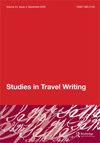Fellow travellers and Soviet Russia’s guides in 1930s travel books by Antoni Słonimski, Robert Byron and Walter Citrine
Q2 Arts and Humanities
引用次数: 0
Abstract
ABSTRACT Most foreign visitors who went to Soviet Russia in the 1930s were so-called “fellow travellers”: the left-wing intellectuals interested in and generally supportive of the “Soviet experiment”. Their standard way of seeing the country was through organised tours, on which they were given guides who served as interpreters and also as informers for the authorities. This article analyses and compares the ways in which such guides and fellow travellers are represented, and the narrative functions that they serve in three travel books, one Polish and two British, published during that decade. These are: Antoni Słonimski’s Moja podróż do Rosji [My Journey to Russia] (1932), Robert Byron’s First Russia, Then Tibet (1933), and Walter Citrine’s I Search for Truth in Russia (1936).Antoni słonimski、Robert Byron和Walter Citrine在20世纪30年代的旅行书籍中的同行旅行者和苏俄导游
摘要20世纪30年代,大多数前往苏俄的外国游客都是所谓的“同路人”:对“苏联实验”感兴趣并普遍支持的左翼知识分子。他们游览这个国家的标准方式是有组织的旅行,在旅行中,他们会得到导游,担任翻译和当局的线人。本文分析和比较了这十年出版的三本旅行书,一本是波兰语,两本是英国语,对这些导游和同行的表现方式,以及它们的叙事功能。这些是:安东尼·索尼姆斯基的《我的俄罗斯之旅》(1932年)、罗伯特·拜伦的《第一个俄罗斯,然后是西藏》(1933年)和沃尔特·奇特林的《我在俄罗斯寻找真相》(1936年)。
本文章由计算机程序翻译,如有差异,请以英文原文为准。
求助全文
约1分钟内获得全文
求助全文
来源期刊

Studies in Travel Writing
Arts and Humanities-Literature and Literary Theory
CiteScore
0.40
自引率
0.00%
发文量
13
期刊介绍:
Founded in 1997 by Tim Youngs, Studies in Travel Writing is an international, refereed journal dedicated to research on travel texts and to scholarly approaches to them. Unrestricted by period or region of study, the journal allows for specific contexts of travel writing to be established and for the application of a range of scholarly and critical approaches. It welcomes contributions from within, between or across academic disciplines; from senior scholars and from those at the start of their careers. It also publishes original interviews with travel writers, special themed issues, and book reviews.
 求助内容:
求助内容: 应助结果提醒方式:
应助结果提醒方式:


